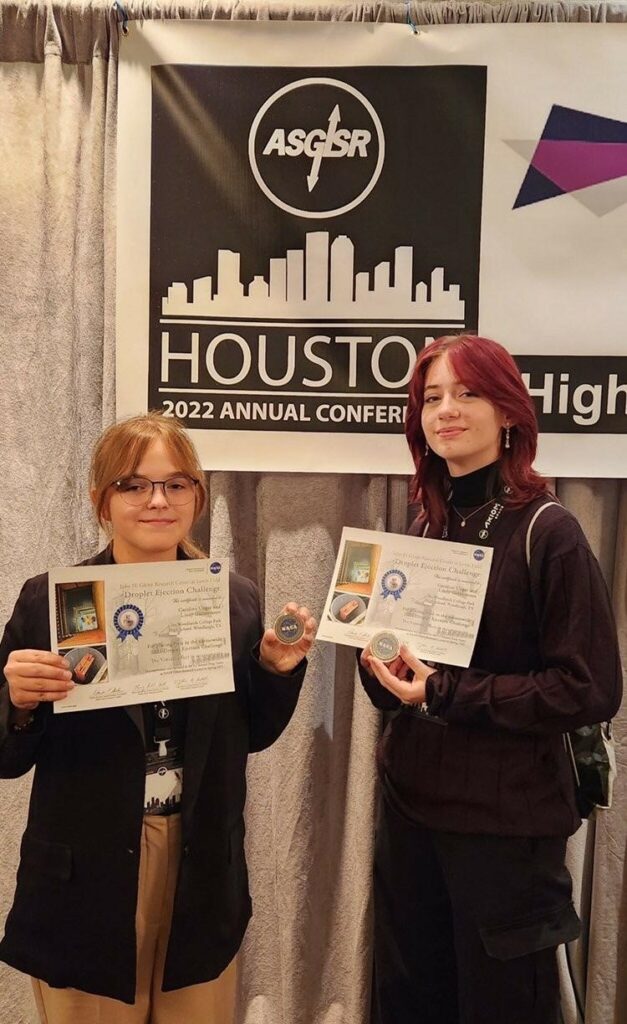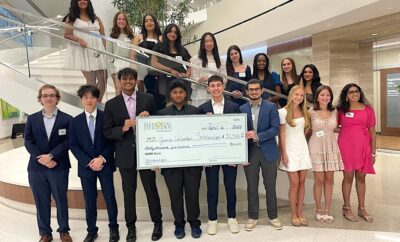
Lifestyle
College Park Students Win 1st Place in the National NASA Drop Tower Challenge
This story is being featured as a result of a partnership between the Conroe ISD Communications Department and high school journalism teachers. Visit the College Park High School website to learn more about their student journalism program. This story was written by Eleanor Kelly, Junior at The Woodlands College Park High School.
CONROE, TX – Normally, school science experiments require simple materials that everyone has, but for two students, their experiment requires assistance from NASA.

Juniors Caroline Unger and Lindy Guttormson created a way to direct fluid motion without microgravity, or weightlessness, winning 1st place at the 2021 Droplet Ejection Challenge.
“We invented microgravity systems that could promote life on Mars,” Unger said.
The Droplet Ejection Project was created to examine the process of capillary flow, a liquid flowing through a narrow space, through microgravity droplet ejection. Finalists at the competition will have the opportunity to have their capillaries tested at the Glenn Research Center in Cleveland, Ohio.
“The overall experience wasn’t hard; it was just a lot to do. We both have super busy school lives so it was hard to find time we could really sit down and get work done together,” junior Lindy Guttormson said.
The pair found out about the project during their freshman year. Both of them wanted to further explore their passion for space exploration, and this project will help scientists direct fluid in vessels within spacecrafts.
“The process was definitely challenging, yet very rewarding. Having to come up with the design for the tube was a challenge within itself,” Unger said.
The project required them to design and build a simple device using capillary flow to eject water droplets as far as possible. They found that their best bet was to model the Venturi effect. The Venturi effect happens when there is a constant energy, and the velocity of a fluid passing through the small area increases and its pressure decreases. They created three tubes of different lengths, hypothesizing that the longest tube would move the droplets the furthest. They used balloons to test straw prototypes of their Venturi capillaries to clearly see the stream of water ejection through each.
“Lindy and I had a blast simulating the drop test at home. It was an interesting sight, since we placed my phone in a ziploc bag within a cooler, which we proceeded to drop off of our balcony to observe the brief microgravity,” Unger said.
In order to test the capillary they created, the duo simulated NASA’s microgravity test. The two simulated it with a cooler, containing Unger’s phone while it videoed what was happening to the water droplets as they fell from the tube within the cooler, as it was dropped 25 feet from a balcony.
“Going to the conference was ridiculously cool. It reminded me of the scene in Big Hero 6 where all of the students were presenting their game changing inventions, except with high schoolers who had invented microgravity systems that could promote life on Mars,” Unger said.
Initially they had submitted their proposal in November of 2020, and the drop trails were supposed to happen in Spring 2021, but due to COVID-19 restrictions it could not happen until this year. During that time, the team continued developing their design in CAD software, and then began to create their devices after meeting with NASA staff. In April of 2022, they sent their final designs to the Glenn Research Center.
“Presenting our project to all these crazy smart people made me realize I really had a strong grasp on what I was talking about, and it made me feel really empowered and confident,” Guttormson said.
Their final product was able to eject a water droplet up to 6 millimeters away, without the use of a pump. Because of their experiment they are able to assist in developing further applications for the Venturi effect in microgravity, this will help with things like spacecraft fuel thrusters and water filtration systems.
“The goal of the project was to design a narrow tube-shaped device that can propel water droplets without the use of a pump in microgravity. We were able to do this utilizing capillary flow, a phenomenon that allows water to flow upward in narrow passages in microgravity. Our design modeled the Venturi effect, which is the increase in liquid flow speed as a result in a constriction halfway through the tube.”




























